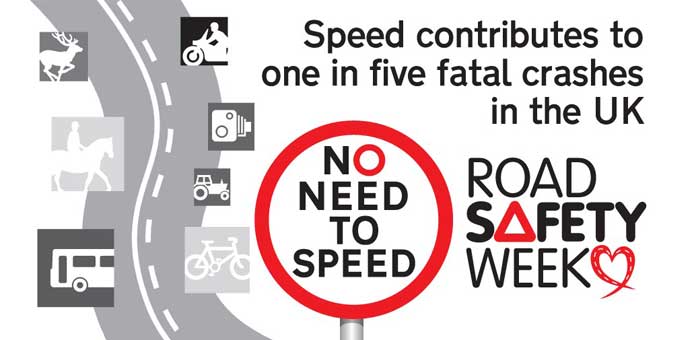Today marks the start of Road Safety Week in the UK.

This week is coordinated by road safety charity Brake, who offer support to people affected by road traffic accidents as well as running a number of campaigns like Road Safety Week to help raise awareness on issues that affect the safety and mobility of all road users.
It might surprise you to know that Road Safety Week is now in its 23rd year. Originally founded in 1997 by Brake, each year the campaign focus on a particular area of concern on the roads. Over the years it has highlighted a number of issues, including awareness of other road users, cyclists and pedestrians.

This year the campaign is No Need to Speed and focuses on raising awareness for the importance of keeping to speed limits.
Across the UK there are a number of speed limits at 10 mph intervals from 10 mph to 70 mph. In urban areas, the limit is usually 30mph unless otherwise stated. The national speed limit is 60 mph on single carriageways and 70mph on dual carriageways and motorways.
Speed limits are designed to ensure drivers have enough time to react to any potential hazards that might occur in that environment.
This year’s Road Safety Week is drawing attention to these speed limits and the need to comply with these.
According to Brake, on average, five people die every day on the road in Great Britain and countless more are seriously injured.
One of the contributing factors in a lot of road traffic accidents is speed and there’s a lot of research that links speed to accident frequency and severity.
Nilsson’s Power Model is one of the best-regarded and most used models that looks at the specific relationship between speed and accidents involving serious injury or fatalities. It illustrates that a 5% increase in average speed leads to approximately a 10% increase in all injury accidents and a 20% increase in fatal accidents. This correlation is why speeding is such a big concern for road safety charities like Brake.
Earlier this year the government published a report that looked at speed data from a sample of the Department for Transport’s (DfT) Automatic Traffic Counters, that were chosen to exclude external factors that might restrict driver behaviour. For example, where there are junctions, hills, sharp bends or speed cameras.
Whilst this report is not reflective of speeds across the entire road network where road layout, traffic calming measures and even the volume of traffic can impact the speed of drivers, it does give us an indication of habits where drivers can drive freely without restrictions.
This year’s results found that 54% of cars exceeded the speed limit on motorways, 50% exceeded it on roads with a speed limit of 30 mph, and 9% on single carriageways with a national speed limit in place. However, when you look at the proportion of cars exceeding the speed limit by more than 10 mph this drops to 12% on motorways, 6% on 30 mph roads and 1% on 60 mph roads.
The report also states that overall vehicle compliance with speed limits has remained broadly stable since 2011, and this year the average car speeds under free-flow conditions were close to the speed limit on motorways at 69 mph, and 30 mph roads at 31 mph. and under the speed limit on 60 mph roads at 50 mph. So overall, it appears that drivers are staying close to the speed limits in these free-flowing areas, despite a small number who speed.
Road Safety Week is open for anyone to get involved with and receives support from businesses across the country, large and small, schools, community groups, youth clubs, and individuals. From fundraising activities like bake sales and sponsored walks through to corporate donations and larger community events there’s a number of ways that you can get involved. If you want to find out more about how to take part in Road Safety Week or the official programme of activities then take a look at the Road Safety Week website.
For the rest of this week at Xcite Car Lesaing, we’re going to be looking at road safety in general and reducing your speed, safety tips for young drivers and other road users as well as maintenance to help keep your vehicle safe and asking that controversial question of who’s the safer driver, men or women? So, keep your eyes open for our daily road safety blogs, and let us know in the comments below if you have any top safety tips of your own!









Leave a Comment